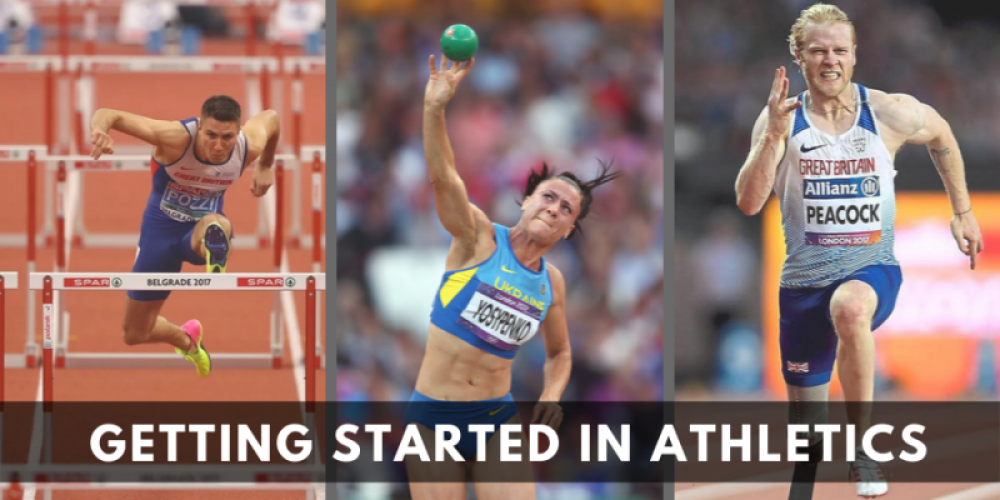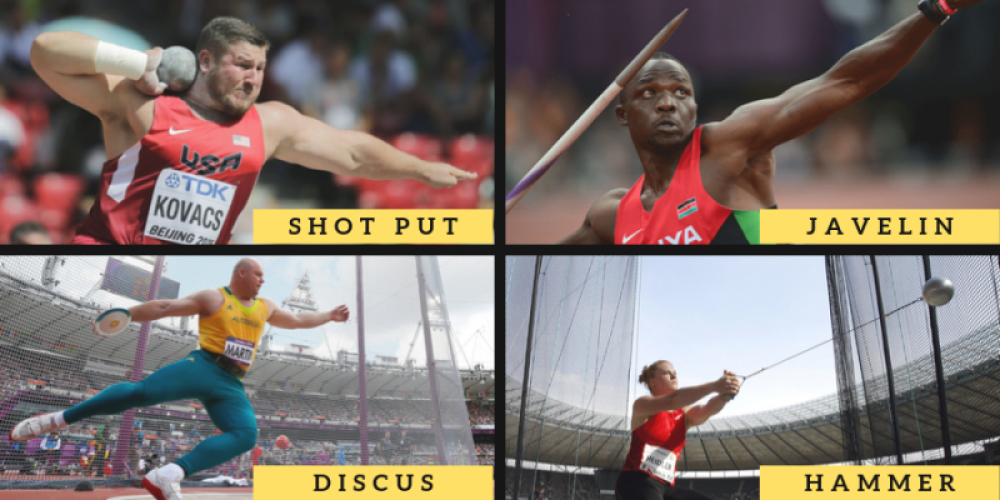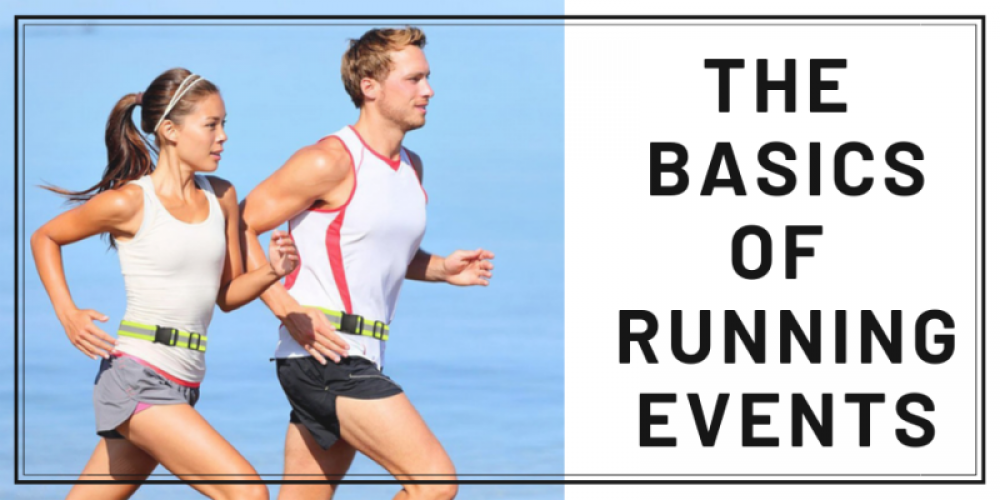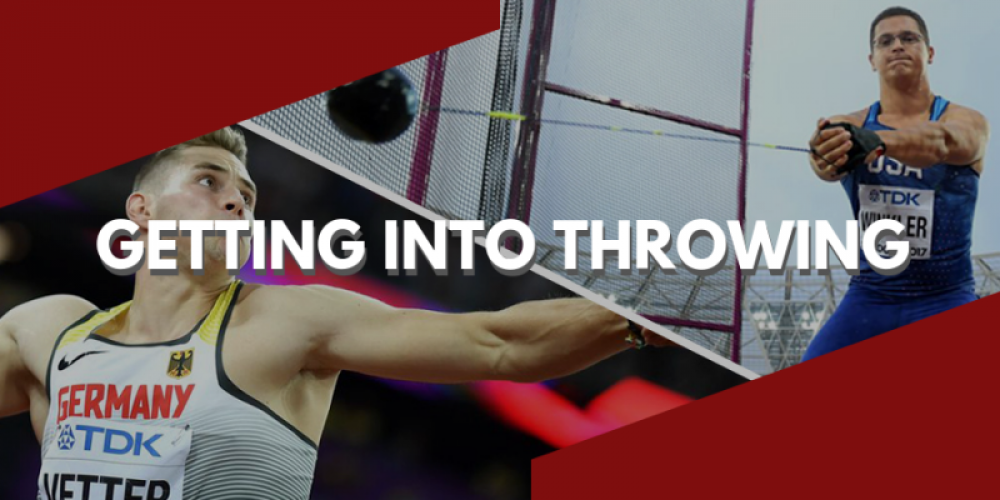
Athletics is mostly running, but can also be jumping and throwing or a combination of all of the above. This means that regardless of your size or shape there is guaranteed to be something to suit you, plus the popularity of athletics means that there are clubs all over the UK.
Getting started in athletics
Basically, getting started in athletics means choosing a discipline (we’ll talk more about them later), possibly buying some fairly basic gear and then deciding whether or not you want/need to join a club. Essentially, if you’re going for track racing, jumping or throwing disciplines and/or you want to compete, then your best bet is to join a club. The UK Athletics website is a good place to start looking (or just check the internet for your local area).

If you want to do off-track running and don’t want to compete then you may still want to join a club for the social aspect, but you could just train on your own if you preferred (or a combination of both). Check out our article on how to get started in running for some tips.
A brief guide to athletics disciplines
Since there are so many options in athletics, we’ve decided to split them out. Here’s a list to see if anything takes your fancy and, if so, have a look further down the article for some more information on it.

Running events
- Standard sprints - 100m, 200m and 400m
- Hurdles - 100m/110m (W/M), 400m
- Middle-distance events - 800m, 1500m, 3000m
- Steeplechase - 300m with hurdles and a water jump
- Long-distance events - 5000m, 10,000m and marathon (26.2 miles)
- Cross-country - no set distance but usually 5,000+
- Race walking - anything from 3000m to 1,000m, Olympic distances are 20,000m (M/F) and 50,000m (men only).
- Parkrun - 5,000m events which take place in parks.
There are also some niche disciplines which are essentially spin-offs from the main athletics disciples such as fell-running and ironman.
Throwing events
- Shot put
- Javelin
- Discus and Hammer

Jumping events
- Long jump
- Triple jump
- High jump

Multi-sport disciples
- Pentathlon: fencing, swimming, show jumping, pistol shooting and cross-country running
- Heptathlon (women): 100 meter hurdles, high jump, shot put, 200 meters, long jump, javelin and 800 meters
- Decathlon (men): 100-metres, running long jump, shot put, high jump, 400-metres, 110-metre hurdles, discus, pole vault, javelin, and 1,500-metres.
The basics of running events

You’ll need different footwear depending on whether you’re running on a track or road, but otherwise you just need clothing in which you can move comfortably. For track running, generally you’ll wear shorts and a vest/t-shirt when you’re actually running and then put on a track suit to keep you warm when you’re not. For road running, you need to dress for the weather, but remember that your body will warm up as you run and cool down when you stop, so think about thermals and layering.
Standard sprints - 100m, 200m and 400m
Sprinting is very high-intensity. Regardless of distance, you absolutely must power off from the start, because you are unlikely to be able to make up time later, especially not in the 100M, which is basically a straight dash between the lines with no real strategy. The 200M and 400M both have an element of strategy involved, but even these are mainly about physicality rather than psychology.
Hurdles - 100m/110m (W/M), 400m
Hurdling carries all the challenges of sprinting, plus there are hurdles to jump. These days, the height of the hurdles is set at 76.2cm/91.4cm (W/M). All three race distances include 10 hurdles, which means that the distance between hurdles is much shorter in the 100/110m than it is in the 400m. Although hurdling is also mainly about power, there’s also a lot of technicality to it and some strategy.
Steeplechase - 300m with hurdles and a water jump
Steeplechasing is basically everything hurdlers have to do but with a water jump thrown in for good measure.
Middle-distance events - 800m, 1500m, 3000m
Middle-distance runners still need strength and speed, but these are the distances where tactics and strategy really start to come into play, along with the ability to tough it out when fatigue sets in but there’s still a race to be won. While sprinting is all about (or mostly about) the start, middle-distance running is often more about the finish and the ability to pick up the pace when the bell rings for the final lap and the fight to the wire really begins.
Long-distance events - 5000m, 10,000m and marathon (26.2 miles)
Long-distance events are also known as endurance events. There’s a good reason for this but don’t let it fool you. The current world record for the men’s marathon is 2:01:39, which means that the holder, Eliud Kipchoge was running at only slightly less than a four-minute mile over 26 miles. Women’s record holder Paula Radcliffe set a time of 2:15:25, so about 5 miles per minute over 26 miles.
Long-distance events are basically like middle-distance events, but with less emphasis on speed and more emphasis on endurance. Tactics and strategy are vital and your technique has to be spot on.
Parkrun - 5,000m events which take place in parks
Parkruns are basically fun runs which take place at over 650 locations throughout the UK (and more are being added all the time). The Parkrun organization is a company but all events are free (and they aim to keep them that way). They are supported by sponsors and a network of volunteers. If this sounds good to you, then visit their website and register so you can attend any of their events.
Cross-country - no set distance but usually 5,000+
Basically this is long-distance running but in the great outdoors, which can give you all kinds of interesting terrain to deal with, but it can also give you some great scenery to enjoy. Cross-country running is a competitive sport, but many people participate in it just for fun.
Race walking - anything from 3000m to 1,000m, Olympic distances are 20,000m (M/F) and 50,000m (men only)
Although race walking is often referred to as “speed walking” it is actually quite different. Speed walking is just walking quickly, basically you can use any technique you like. Race walking requires participants to keep one foot on the ground at all times and to keep the knee of the forward foot in a straight position (i.e. not bend it) from the point the forward foot makes contact with the ground to the point where it passes underneath the body.
In other words, race walking is not a natural motion at all, which means it’s often best learned from a coach, even if you don’t want to join a club or compete, although these days there are plenty of videos (and articles) to show you how it’s done.
The key point about race walking is that the limitations of what you can do with your legs means that arm movements are even more important than they are in regular running and getting them right can make a huge difference to your speed.
It has to be said that race walking as a sport enjoyed its peak from about 1860 to about 1903 when race walkers could earn big money and race walking events saw huge bets being made. It was still popular in the early 20th century, hence its introduction to the Olympics in the 1906 “interim” games (held in Athens), but, rather ironically, its following began to decline shortly thereafter, although the sport held onto its place in the games (with a few exceptions).
To be perfectly honest, it’s highly questionable whether or not the sport should have held its place in the Olympics for as long as it did, given that much more popular sports (such as netball) couldn’t (and still can’t) get one of the limited (and highly-coveted) spaces. It was probably just as well for race walking that it did because the 2012 (London) Olympics helped to bring the sport back into the public eye.
All three events set new Olympic records, plus the women’s 20Km set a new world record, so there was a high level of buzz around the event, especially in the UK (which was hosting the games) and in the winners’ home countries. Since then, race walking has been making something of a comeback as a competitive sport although it’s still some way off the popularity it enjoyed in its glory days.
If you want to compete at race walking then, bluntly, you’re going to need to be serious about the training, race walkers do every bit as much of it as runners. They are elite endurance athletes. The key word in that sentence is “endurance”, mental as well as physical. Never underestimate just how gruelling longer races can be. Using the right strategy is essential and your technique has to be spot on because errors will multiply over the long distances.
Learning race walking technique can stand you in good stead as a runner because it can massively increase your speed over long distances if you’re using the run-and-walk approach described in our article on how to get into running.
Getting into throwing events
If you want to get into the throwing events, then really you’re going to need to join a club as you’ll need access to special equipment and you’ll also need to learn the necessary techniques.

Shot put, javelin, discus and hammer
None of these events involves any real strategy but they do involve a whole lot of technique. While the exact approach to each is different, the basic idea is that you use your core body and your legs for strength and stability and use your body weight to accelerate in preparation for the release. This means that athletes in throwing events need strength throughout their whole body, not just their arms and upper body.
Getting into jumping events
Again, if you are interested in getting into jumping events, you will really need to join a club to get access to the equipment and coaching.

Long jump, triple jump, high jump and pole vault
Jumping events don’t really involve strategy, but they do require participants to have finely-honed technique along with speed, strength, flexibility and in the case of the pole-vault, nerves of steel. The pole vault world record (held by Renaud Lavillenie of France) is 6.16 metres, for comparison, a double-decker bus is about 4.5m in height.
Getting into the multi-sport disciples
The key point to understand about the multi-sport disciplines is that you’re not expected to achieve the same standards as the athletes who specialize in any one discipline. The idea behind the multi-sport disciplines, as the name suggests, is to create an all-round athlete. If you’re interested in one of these disciplines, then you’re really going to need the backing of a club as you’re going to need an awful lot of coaching in technique plus access to equipment.
In short
You could make a case for arguing that athletics is a bit of a “catch-all” discipline for all the events which couldn’t make it in any other category. That may be true, but if so it’s something to be proud of because it means there really is something for everyone.
In practical terms, it’s usually very easy to get involved in most athletic disciplines for the simple reason that there are athletic clubs up and down the country and while some are specifically for children, many are happy to take new members of all ages.
Remember that clubs are about participation rather than competition. In other words, clubs may encourage you to compete and will train and support you if that is your choice, but it will be your choice, nobody will try to pressurize you into competing if you don’t want to.
The off-track running disciplines can all be practiced in a club or on your own. In fact, you can even train for running without leaving your own home if you invest in a treadmill.
Fitness fanatic and always on the move. Carly is a certified personal trainer and currently teaches spin class, Zumba, and Body Pump amongst a few others. Carly has a PhD/MSc in Sport and Exercise Nutrition so she really knows her stuff and has worked in fitness and health all her life. We are honoured to have her as a member of the team. Carly has an infectious laugh, loves terrible, terrible jokes and her dog Trevor and often works with a local mental health charity













